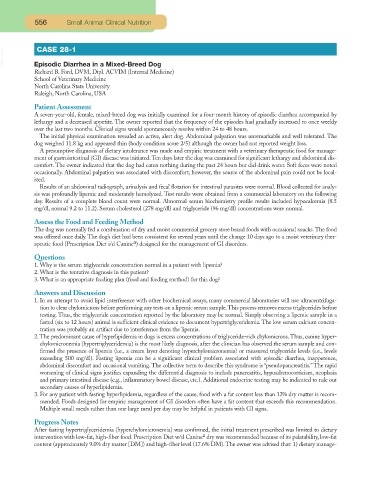Page 538 - Small Animal Clinical Nutrition 5th Edition
P. 538
556 Small Animal Clinical Nutrition
CASE 28-1
VetBooks.ir Episodic Diarrhea in a Mixed-Breed Dog
Richard B. Ford, DVM, Dipl. ACVIM (Internal Medicine)
School of Veterinary Medicine
North Carolina State University
Raleigh, North Carolina, USA
Patient Assessment
A seven-year-old, female, mixed-breed dog was initially examined for a four-month history of episodic diarrhea accompanied by
lethargy and a decreased appetite. The owner reported that the frequency of the episodes had gradually increased to once weekly
over the last two months. Clinical signs would spontaneously resolve within 24 to 48 hours.
The initial physical examination revealed an active, alert dog. Abdominal palpation was unremarkable and well tolerated. The
dog weighed 11.8 kg and appeared thin (body condition score 2/5) although the owner had not reported weight loss.
A presumptive diagnosis of dietary intolerance was made and empiric treatment with a veterinary therapeutic food for manage-
ment of gastrointestinal (GI) disease was initiated.Ten days later the dog was examined for significant lethargy and abdominal dis-
comfort. The owner indicated that the dog had eaten nothing during the past 24 hours but did drink water. Soft feces were noted
occasionally. Abdominal palpation was associated with discomfort; however, the source of the abdominal pain could not be local-
ized.
Results of an abdominal radiograph, urinalysis and fecal flotation for intestinal parasites were normal. Blood collected for analy-
sis was profoundly lipemic and moderately hemolyzed. Test results were obtained from a commercial laboratory on the following
day. Results of a complete blood count were normal. Abnormal serum biochemistry profile results included hypocalcemia (8.5
mg/dl, normal 9.2 to 11.2). Serum cholesterol (278 mg/dl) and triglyceride (96 mg/dl) concentrations were normal.
Assess the Food and Feeding Method
The dog was normally fed a combination of dry and moist commercial grocery store brand foods with occasional snacks.The food
was offered once daily. The dog’s diet had been consistent for several years until the change 10 days ago to a moist veterinary ther-
a
apeutic food (Prescription Diet i/d Canine ) designed for the management of GI disorders.
Questions
1. Why is the serum triglyceride concentration normal in a patient with lipemia?
2. What is the tentative diagnosis in this patient?
3. What is an appropriate feeding plan (food and feeding method) for this dog?
Answers and Discussion
1. In an attempt to avoid lipid interference with other biochemical assays, many commercial laboratories will use ultracentrifuga-
tion to clear chylomicrons before performing any tests on a lipemic serum sample.This process removes excess triglycerides before
testing. Thus, the triglyceride concentration reported by the laboratory may be normal. Simply observing a lipemic sample in a
fasted (six to 12 hours) animal is sufficient clinical evidence to document hypertriglyceridemia. The low serum calcium concen-
tration was probably an artifact due to interference from the lipemia.
2. The predominant cause of hyperlipidemia in dogs is excess concentrations of triglyceride-rich chylomicrons.Thus, canine hyper-
chylomicronemia (hypertriglyceridemia) is the most likely diagnosis, after the clinician has observed the serum sample and con-
firmed the presence of lipemia (i.e., a cream layer denoting hyperchylomicronemia) or measured triglyceride levels (i.e., levels
exceeding 500 mg/dl). Fasting lipemia can be a significant clinical problem associated with episodic diarrhea, inappetence,
abdominal discomfort and occasional vomiting. The collective term to describe this syndrome is “pseudopancreatitis.” The rapid
worsening of clinical signs justifies expanding the differential diagnosis to include pancreatitis, hypoadrenocorticism, neoplasia
and primary intestinal disease (e.g., inflammatory bowel disease, etc.). Additional endocrine testing may be indicated to rule out
secondary causes of hyperlipidemia.
3. For any patient with fasting hyperlipidemia, regardless of the cause, food with a fat content less than 12% dry matter is recom-
mended. Foods designed for empiric management of GI disorders often have a fat content that exceeds this recommendation.
Multiple small meals rather than one large meal per day may be helpful in patients with GI signs.
Progress Notes
After fasting hypertriglyceridemia (hyperchylomicronemia) was confirmed, the initial treatment prescribed was limited to dietary
a
intervention with low-fat, high-fiber food. Prescription Diet w/d Canine dry was recommended because of its palatability, low-fat
content (approximately 9.0% dry matter [DM]) and high-fiber level (17.6% DM).The owner was advised that: 1) dietary manage-

